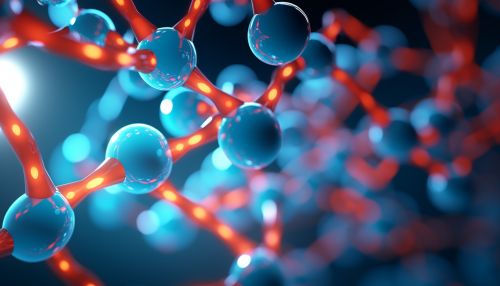Ligand (biochemistry)
Introduction
A ligand in biochemistry is a substance that forms a complex with a biomolecule to serve a biological purpose. In protein-ligand binding, the ligand is usually a molecule which produces a signal by binding to a site on a target protein. The binding typically results in a change of conformational isomerism (conformation) of the target protein.


Classification of Ligands
Ligands can be classified based on their size, charge, and the type of bond they form with their corresponding receptor.
Small Molecule Ligands
Small molecule ligands are generally organic compounds that bind to proteins through non-covalent interactions. These include hydrogen bonds, van der Waals forces, and ionic interactions. Examples of small molecule ligands include drugs, metabolites, and neurotransmitters.
Large Molecule Ligands
Large molecule ligands, also known as macromolecular ligands, are usually proteins or peptides that bind to other proteins. These ligands often induce a conformational change in the protein they bind to, which can affect the protein's function.
Charged Ligands
Charged ligands carry a net positive or negative charge and bind to proteins through ionic interactions. These ligands can be small molecules, like ions, or large molecules, like proteins.
Neutral Ligands
Neutral ligands do not carry a net charge and bind to proteins through non-ionic interactions, such as hydrogen bonding or van der Waals forces. These ligands can also be small or large molecules.
Ligand Binding
Ligand binding is the interaction of ligands with proteins, DNA, or RNA, resulting in a complex that can perform a specific biological function. The ligand-binding site is the specific location on the receptor where the ligand binds.
Mechanism of Ligand Binding
The mechanism of ligand binding involves the ligand approaching the binding site, interacting with the receptor, and forming a complex. This process is influenced by various factors, including the concentration of the ligand, the affinity of the receptor for the ligand, and the presence of other molecules that may compete for the binding site.
Factors Affecting Ligand Binding
Several factors can affect ligand binding, including the concentration of the ligand, the affinity of the receptor for the ligand, the presence of other molecules that may compete for the binding site, and the conformational state of the receptor.
Ligand-Receptor Interactions
Ligand-receptor interactions are crucial for the function of many biological systems. These interactions can trigger a variety of cellular responses, including signal transduction, endocytosis, and changes in gene expression.
Signal Transduction
In signal transduction, the binding of a ligand to its receptor triggers a series of events that lead to a response in the cell. This process can involve the activation of enzymes, the opening of ion channels, or changes in gene expression.
Endocytosis
In endocytosis, the binding of a ligand to its receptor triggers the internalization of the ligand-receptor complex into the cell. This process allows the cell to take in substances from its environment.
Changes in Gene Expression
In some cases, the binding of a ligand to its receptor can lead to changes in gene expression. This can occur when the ligand-receptor complex moves to the nucleus and interacts with the cell's DNA.
Role of Ligands in Drug Design
Ligands play a crucial role in the design of drugs. By understanding how ligands interact with their receptors, scientists can design drugs that can bind to specific receptors and trigger desired responses in the body.
